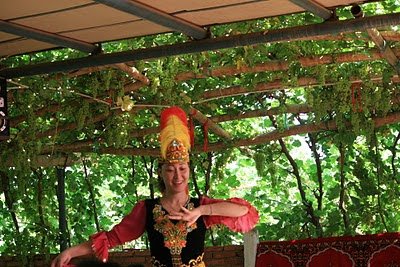 |
| (Girl in local costume) |
 |
| (Ladies with colourful dresses) |
Historically, the integration of different ethnic groups was not easy. There are prejudices between cultures, beliefs and self interests. As Steven Harrell, a social anthropologist, noted that the inequality between the civilizing center and the peripheral peoples has its ideological basis in the center's claim to a superior degree of civilization to the level of the center, or at least closer to that level.
(Harrell, Stevan (ed.). Cultural encounters on China’s ethnic frontiers. Hong Kong: Hong Kong University Press, 1996.)
The recent development of highways and tourist attractions have brought many tourists to visit the homeland of Tujia. Their beautiful natural environment and unique cultures are parts of tourist attractions.
 |
| (Local farmer with his buffalo crossing the waterfall) |
 |
| (Farm land surrounded by mountains) |
In the Northwest of China, we met another ethnic group, Uyghur, in Turpan, Xinjiang. There are different stories about the origin of Uyghur. The common one is that Uyghur migrated from Mongolia into the Tarim Basin around the ninth century. They assimilated with the local Indo-European population.
Turpan is an oasis surrounded by deserts. Water from the Tianshan mountains keeps the life line of Turpan. Melted snow flows into underground water that travels thousands of kilometers beneath the deserts before reaching Turpan. For decades, Uyghur people dug long lines of wells and brought underground water to their farmlands and vineyards.
 |
| (Local Uyghur in Turpan) |
 |
| (Uyghur girl dancing for her guests in a vineyard) |
Turpan was one of the stopping points along the ancient Silk Road. Travellers and caravans got their supplies there for their long journeys. We are amazed to see that Turpan still maintains rich cultivation of grapes, mulberry and vegetables.
 |
| (Grapes ready for harvest) |
沒有留言:
張貼留言